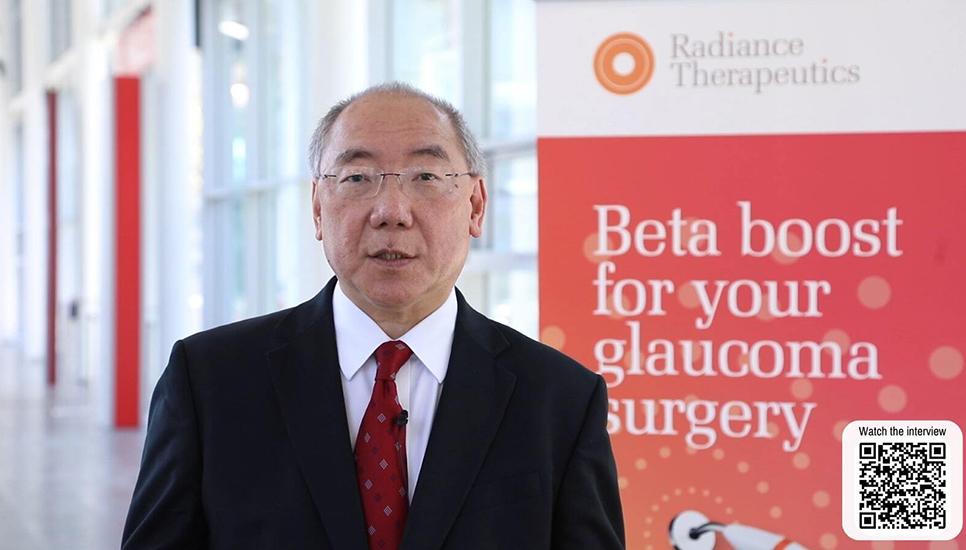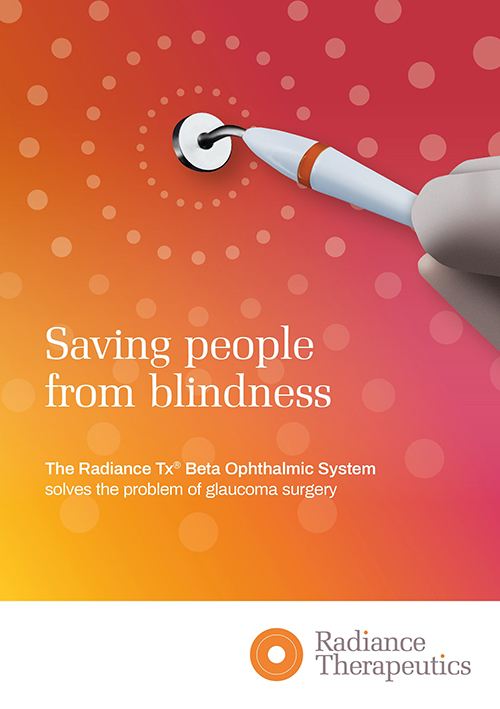Radiance Therapeutics: Pioneering sight-saving technology

Radiance Therapeutics is commercialising a clinically proven moonshot medical device to treat glaucoma: using this therapy, significantly fewer patients will go blind.
The Radiance story is compelling. Four ‘gold standard’ randomised controlled trials (RCT), supported by the Wellcome Trust, proved the superiority of this treatment over the current standard of care. The therapy was developed at Moorfields Eye Hospital and University College London (UCL), with collaborators worldwide. This heralded breakthrough was led by consultant ophthalmic surgeons Professor Sir Peng Khaw and Ian Murdoch MBE - both renowned physicians and innovators were honoured by the Queen’s in her New Year’s Honours in recognition of their work in prevention of blindness.
Radiance is an early growth stage company prominent within the glaucoma devices market. Recently, Radiance received both US FDA 510(k) regulatory clearance and a US patent. These commercial milestones endow the company with IP-protected and regulator-approved market access to the world’s richest medical device economy. The company is also actively pursuing commercialisation in the UK, EU, other OEDC and Chinese markets enabled by worldwide patents and patents pending.
Glaucoma is a chronic, progressive disease that damages the nerves that sense and transmit visual signals to the brain. This damage is caused by the build-up of excess pressure within the eye, known as intraocular pressure (IOP). In patients with mild-to-moderate glaucoma, IOP may be controlled with the use of medicated eye drops. Whereas patients with moderate-to-severe glaucoma require surgery to relieve the excess pressure and prevent sight-stealing damage to the optic nerves. This surgery shunts fluid out of the eye through a channel created to maintain lower IOP.
Unfortunately, glaucoma drainage surgery fails in 50% of patients within three years, due to post-operative scarring. This scarring restricts fluid drainage, leading to elevated IOP and progressive vision loss. This is an outsized failure rate with a devastating impact: blindness.
 The staggering 50% failure rate of glaucoma drainage surgery within three years is recognised by the ophthalmic community as an urgent and critical unmet need.
The staggering 50% failure rate of glaucoma drainage surgery within three years is recognised by the ophthalmic community as an urgent and critical unmet need.
Radiance Therapeutics is commercialising a breakthrough technology that dramatically reduces surgical failure rates and thus prevent glaucoma-induced vision loss. The Radiance Beta Ophthalmic Applicator provides clinically validated, superior outcomes in treating glaucoma. The treatment involves a single application of beta therapy, a minimally invasive, highly targeted form of radiation, that prevents postoperative scarring.
Rarely in medicine are such clinically significant improvements in efficacy achieved. Four RCT studies enrolling more than 788 patients found that the use of beta therapy increased the success from 50% to 90%. These compelling results have been published in the British Medical Journal (BMJ) and other prestigious peer-reviewed medical journals.
“Beta therapy has the potential to enhance surgical success rates and offers a promising solution for achieving and maintaining safe intraocular pressure levels in glaucoma patients throughout their lifetimes,” says Sir Peng. “It has significant implications in reducing the burden on healthcare systems, and ultimately improving the quality of life for individuals affected by glaucoma.”
Beta therapy enables glaucoma treatment to achieve the ambitious ‘10-10-10 goal’ – intraocular pressure reduced to 10mmHg (a healthy pressure), achieved with a quick, ten-minute procedure and yielding results that last for at least ten years. It’s a one-and-done intervention uniquely suited to preventing vision loss and blindness.
Radiance CEO Dr Laurence Marsteller summarised the company’s plans to address blindness worldwide: “Our disruptive medical technology will soon debut in advanced economies, and we anticipate that it will do no less than completely transform the practice of glaucoma treatment.”
The glaucoma devices market boasts a 40% CAGR and an active M&A. In addition, there is significant growth in demand in Asian markets for ophthalmic therapeutics.
“We are approaching an inflection point as an early growth stage company,” continues Dr Marsteller, “Radiance is seeking commercialisation funding to enable delivery of the devices to ophthalmologists who are eager to offer this important therapeutic advance in glaucoma therapy to their patients.”
In addition, the company has a commitment to underserved populations.
Preventing vision loss in developing countries is more challenging because most anti-glaucoma drugs are either too costly, counterfeit, or entirely unavailable. Even generic drugs may cost more than necessities such as food. Addressing these medical challenges entails balancing cost, affordability, and access to care. In many parts of the world, it is practically impossible for patients to obtain and remain on treatment.
Mr Murdoch and his colleagues in Africa have studied and extensively tested the beta therapy treatment as it does not require the infrastructure and specially trained ophthalmologists necessary for the pharmaceutical and surgical interventions of high-income countries. Their work was supported by the International Glaucoma Association, Fight For Sight, and the British Council for the Prevention of Blindness. These clinical studies in Africa, over nearly 20 years, have produced remarkable results. Beta radiation substantially reduced the risk of surgical failure after glaucoma surgery.
“Notably, beta therapy is particularly well-suited for use in resource poor situations because it’s applied quickly, is affordable, and its effects are durable,” says Murdoch.
Dr Marsteller summarises the company’s commitment to social responsibility: “While we continue to commercialise in high-income countries, we aim to concurrently introduce beta therapy in Sub-Saharan Africa. Our goal is to bring state-of-the-art glaucoma care to those unserved or underserved by advances in ophthalmological technology. This is a core value of our company and our commitment to help reduce suffering, wherever it occurs.”
“We believe Radiance Therapeutics represents a unique investment opportunity. It is exceptional in terms of its impact, scope, projected ROI, and potential to sharply reduce both the personal suffering and broader economic impact of the preventable onset of vision loss and blindness around the world.”







